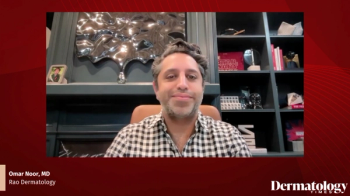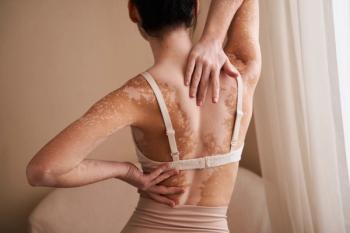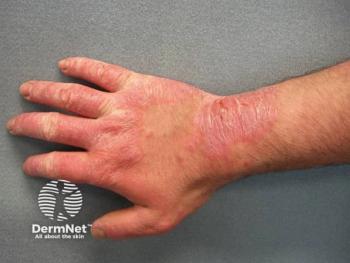
- Dermatology Times, New Directions in Topical Therapy for Atopic Dermatitis, October 2025 (Vol. 46. Supp. 07)
- Volume 46
- Issue 07
Topicals in Action: Real-World Patient Cases in Atopic Dermatitis Management
Key Takeaways
- Systemic therapy, including biologics and JAK inhibitors, is preferred for chronic, uncontrolled AD with significant impact on daily life.
- Early specialist involvement and non-steroidal agents are crucial for managing head and neck AD, especially in younger patients.
Robert Koppel, MD, led Case-Based Roundtable attendees through 3 complex cases of atopic dermatitis that centered around available non-steroidal topicals and biologics.
A recent
Case 1: Chronic, Uncontrolled AD
The first case presented a 32-year-old man with longstanding, poorly controlled AD, visibly excoriated skin, and significant pruritus that was disrupting both sleep and daytime functioning. Despite clear clinical indications for systemic therapy, including involvement of approximately 10% body surface area (BSA), previous topical treatments had failed to bring meaningful relief.
“I think we all agreed that the 10% BSA estimate might have been low,” Koppel said. “Just judging from the photo and the extent of his symptoms, it seemed like this patient was well beyond the point where topical therapy alone would suffice.”
The roundtable attendees leaned toward topical options such as ruxolitinib cream (Opzelura; Incyte), but the consensus leaned more toward systemic therapy—biologics or JAK inhibitors—as a better fit, particularly given the chronicity and impact on daily life. Still, Koppel acknowledged the evolving topical landscape: “If the topicals he’s been using haven’t helped, he might benefit from something new, like roflumilast, tapinarof, or ruxolitinib.”
Case 2: Head and Neck AD
Next, the group discussed a 16-year-old girl with head and neck AD, a presentation that carries not only clinical complexity, but also heightened psychosocial visibility. Previously treated with conventional topicals without success, the patient’s family was ready to consider more effective solutions.
A significant portion of the discussion shifted toward social media-driven awareness of steroid withdrawal syndromes, with some participants—especially more senior clinicians—hearing about the topic for the first time. The group discussed the importance of early specialist involvement and the promise of non-steroidal agents such as ruxolitinib and tapinarof (Vtama; Organon) in younger patients who’ve exhausted older treatment options.
From a systemic standpoint, the patient’s age makes her eligible for all 3 FDA-approved biologics: dupilumab (Dupixent; Sanofi and Regeneron), tralokinumab (Adbry; LEO Pharma), and lebrikizumab (Ebglyss; Eli Lilly and Company), though coverage hurdles and the family's comfort with injectables remained key factors.
The discussion also surfaced an all-too-common issue: delayed referral. The teen had yet to see a dermatologist, with the primary care provider deeming previous treatment “sufficient.”
Case 3: Pediatric AD
The final case involved a 9-year-old boy with worsening AD symptoms who had received a diagnosis at 3 years old. He has primary involvement of the flexural folds of the elbows and knees, and his parents report that he is constantly scratching himself in his sleep.
“This really came down to quality of life,” Koppel said. “The sleep disturbance, the constant scratching—it affects the whole family.”
The patient had been previously treated with several topicals, including corticosteroids (initiated at diagnosis and used intermittently for flares with minimal efficacy), calcineurin inhibitors (partial response, but flares continued), and oral antihistamines (minimal impact on itch relief).
Koppel reviewed data from the TruE-AD3 trials evaluating ruxolitinib in pediatric patients with AD. Patients aged 2 to 11 years were randomly assigned 2:2:1 to receive 8 weeks of continuous treatment with 0.75% ruxolitinib cream twice daily, 1.5% ruxolitinib cream twice daily, or vehicle. In patients aged 2 to 6 years, 60.6% of patients who received ruxolitinib cream 1.5% achieved investigator's global assessment treatment success. In patients aged 7 to 11 years, 52.3% of patients who received ruxolitinib cream 1.5% achieved investigator's global assessment treatment success.1
For pediatric patients, ruxoitinib cream is expected to receive an expanded indication for patients aged 2 to 11 years with atopic dermatitis in
Community Learning
Beyond the clinical pearls, the roundtable event emphasized the value of peer dialogue.“The value of Case-Based Roundtables is tremendous. Being able to get together and discuss these clinical vignettes and have a meeting of the minds where we're sharing in person, not online, and actually seeing each other, and the ability to discuss these cases is just invaluable, Koppel said. The inclusion of diverse professional voices—MDs, PAs, and NPs—added dimension and practicality to the conversation.
Key Takeaway
Koppel’s roundtable was a reminder that while AD treatment options are expanding rapidly, gaps remain in how and when they're used, especially in pediatric populations. Whether it’s the availability of new non-steroidal topicals or emerging data on pigment changes, staying current and collaborative remains essential to delivering comprehensive care.
References
- Soong W, Zaenglein A, Tollefson M, et al. Long-term safety and disease control of ruxolitinib cream in children aged 2 to 6 and 7 to 11 years with atopic dermatitis: results from the TRuE-AD3 study. Presented at: American Academy of Allergy, Asthma & Immunology/World Allergy Organization Joint Congress; February 28-March 3, 2025; San Diego, CA
- Update on FDA review of ruxolitinib cream (Opzelura) for children ages 2-11 with atopic dermatitis. News release. Incyte. June 20, 2025. Accessed August 8, 2025.
https://investor.incyte.com/news-releases/news-release-details/update-fda-review-ruxolitinib-cream-opzelurar-children-ages-2-11
Articles in this issue
Newsletter
Like what you’re reading? Subscribe to Dermatology Times for weekly updates on therapies, innovations, and real-world practice tips.



















